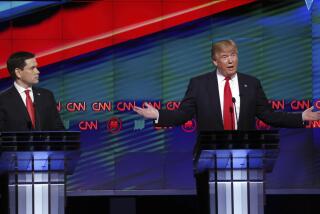Bitter Infighting Follows Victories : Supply Siders Divided on Success of Tax Revolution
- Share via
WASHINGTON — When President Reagan last year signed into law a sweeping tax overhaul bill lowering the maximum effective individual rate to 33%--less than half the 70% that prevailed when he entered office--”supply siders” should have been dancing for joy.
In less than a decade, this tiny band of iconoclastic economists, conservative politicians and talented propagandists with an overriding zeal for lower tax rates had transformed “supply-side economics” from an obscure cult into a full-fledged revolution in fiscal policy.
Like many revolutions, however, the supply-side movement began to splinter almost from the moment of its first stunning victories. And instead of celebrating their unprecedented triumph in persuading Congress to drastically cut tax rates, supply siders have been spending most of their time in recent years fighting among themselves.
What generally distinguishes supply siders is their belief that producers of goods and services are what drive the economy. If government policies favor business activity, they argue, markets will develop for what business produces.
Thus supply siders favor tax cuts for business and lowered tax rates for high-income individuals, whereas more traditional economists focus on the “demand side”--the consumer--and urge government policies that spur consumer demand, such as lower taxes for the middle class. But last year’s tax overhaul cleaved the supply-side movement in two. Some adherents--notably the Washington-based economists--decried the increase in business taxes, while others--particularly the non-economists--cheered the reduction in individual tax rates.
Former allies are at each other’s throats: USC economist Arthur Laffer against Rep. Jack Kemp (R-N.Y.); Washington tax economist Norman Ture versus supply-side popularizer Jude Wanniski; former Treasury official Paul Craig Roberts against practically everybody.
“Shared adversity united the supply siders in a special mission, but they really didn’t have all that much in common,” said John Rutledge, head of the Claremont Economics consulting firm and a fellow traveler in the supply-side movement. “It’s just like Che Guevara and Fidel Castro. Any winning revolution ends up splitting apart the revolutionaries.”
In Danger of Losing War
So, despite the series of political battles they have won in recent years--beginning with Proposition 13 in California in 1978 and the massive federal tax cut in 1981--supply siders ultimately are in danger of losing the war over the nation’s future economic policies.
“Supply siders are victims of our success,” conceded Bruce Bartlett, one of the earliest members of the group and now a senior economist at the conservative Heritage Foundation. “What worries me is that supply siders don’t have a positive agenda anymore. All we are doing is fighting a rear-guard action.”
Mostly that means fending off charges that they are responsible for enormous federal budget deficits, which are thought by many economists to be sowing the seeds of future economic decay even as they allow a burst of consumer spending today.
The supply siders had insisted that the 1981 tax cuts would pay for themselves. According to the famous Laffer Curve, the right kind of tax cut should trigger so much economic growth that the resulting new tax revenue should offset the revenue lost to lower tax rates.
But it didn’t work out that way, and the deficit remains the supply siders’ Achilles heel.
‘It’s Like Fertilizer’
“There’s nothing wrong with the supply side that couldn’t be solved by dividing its claims by 10,” Charles L. Schultze, a leading liberal economist at the Brookings Institution, told an interviewer last year. “It’s like fertilizer. The right amount makes your grass grow. Too much kills the grass. Supply siders went so far they got us into the deficit problem.”
Most academic economists are even more scornful of the supply siders, “who have gone nowhere in the profession,” said Arjo Klamer, an economist at Wellesley College in Massachusetts and author of “Conversations with Economists,” a penetrating study of the leading academic economists of the profession.
Klamer pointed out in an interview that supply siders have thrived “in the political arena, where they have been able to evoke images that appeal to the American dream of heroic individuals. But economists resent all that because they are much more cynical and believe in rationality rather than romanticism.”
Supply siders respond that conventional economic theories have failed to explain recent events, such as the economy’s ability to keep growing despite four years of enormous budget deficits and the persistence of only moderate inflation despite rapid growth of the money supply.
“Conventional economics, which has lost the compass of budget deficits or money supplies, is degenerating into mysticism,” contended Alan K. Reynolds, chief economist at Wanniski’s Polyconomics consulting firm in Morristown, N.J.
Lack of ‘Animal Spirits’
He cited a recent magazine article in which a number of established economists were quoted as worrying more about “weakening moral fiber,” a lack of “animal spirits” and “precarious investor confidence” than about the failure of their own predictions.
Unfortunately for the supply siders, however, they have had little better success than their more traditional brethren in accounting for the economy’s unpredictable behavior of recent years. Despite the prolonged expansion since the recessions of the early 1980s, supply siders continue to have difficulty explaining why the 1981 tax cut failed to yield the burst of savings and investment that they predicted.
Princeton economist Uwe E. Reinhardt, in an obituary for supply siders published in a recent issue of the New Republic magazine, argued that supply-side policies failed to increase the share of the nation’s economic output going to capital formation and instead simply promoted an orgy of consumption and government spending.
“Whatever Reaganomics may have been, it was not supply-side economics,” he wrote. “It was politics as usual, practiced to please or at least not to offend powerful political constituencies, and pushed just one step further in the direction of irresponsibility.”
Supply siders offer a variety of defenses against the charge that they are responsible for the soaring budget and trade deficits, which many economists argue are linked.
Fell Short of Expectations
Roberts argues, for example, that the unexpectedly rapid drop in inflation engineered by Federal Reserve Chairman Paul A. Volcker left a huge gap between spending, which Congress left at high levels, and revenues, which fell far short of expectations because of the decline in inflation.
And Reynolds holds that when other nations failed to adopt pro-growth policies of their own, foreign investors drove up the value of the dollar by flooding the United States with capital, which encouraged U.S. trading partners to rely almost solely on exports to the United States rather than growth in their own domestic markets. The American trade deficit, he insists, was a consequence of that imbalance, not of the 1981 tax cuts.
For now, the supply siders are united behind the proposition that raising taxes to narrow the budget gap would be disastrous. Supply-side economists generally advocate slashing government spending, while Kemp, Wanniski and some of the other non-economists believe that the deficits will disappear of their own accord if only other countries will cut their own taxes, boost their economic growth and buy more American goods, thus generating more growth--and tax revenue--in the United States.
Within the supply-side camp itself, the differences that were simmering just under the surface erupted over the recent tax bill. Wanniski, author George Gilder and other non-economists supported the bill on the theory that its lower individual tax rates would spur entrepreneurship; Washington economists such as Ture and Roberts opposed it for fear that its higher business taxes would have exactly the opposite effect.
“The Polyconomics crowd are like loose cannons on the deck,” said Ture, a top Treasury official during Reagan’s first term who now heads a Washington lobbying group. “There really isn’t much real intellectual content behind their support for lower marginal (tax) rates at the expense of raising the cost of capital. I think it is because they simply couldn’t bring themselves to be critical of anything that had White House backing.”
Set Up as High Priests
And Roberts, who is now at the Center for Strategic and International Studies here, contended that the “journalists and newsletter writers who have set themselves up as the high-priest interpreters of supply-side economics make it difficult for economists who are held to professional standards to be associated with the movement. Somehow a school of economic thought that has no economists in it seems unpromising.”
Wanniski, a former editorial writer at the Wall Street Journal, dismisses his critics within the supply-side movement as little more than defenders of the status quo. They refuse to take him seriously, he said, only because he doesn’t “have a Ph.D. in economics.”
The “great struggles” within the movement, he said, “simply spring from the fact that there is as much variation among supply siders as there is among demand siders.”
Wanniski, who takes credit for adopting the “supply-side” label “as a badge of honor,” argued that politicians ranging from Treasury Secretary James A. Baker III to Democrats such as Sen. Bill Bradley of New Jersey and New York Gov. Mario M. Cuomo are “coming to respect the power of the ideas of supply siders because the demand-side theorists keep changing their arguments to suit events they can’t understand.”
Personality and politics have also played a big part in dividing former allies. When Kemp failed to endorse Laffer during his abortive campaign last year to be the Republican candidate to challenge Sen. Alan Cranston (D-Calif.), Laffer lashed back by telling the Washington Times that Kemp’s attacks on Volcker’s tight money policies “are unwarranted, unfounded and incorrect. . . . Jack thinks he could have done a better job? Give me a break.”
Kemp Assailed
Laffer, who helped convince Kemp to introduce in Congress the proposal that grew into the 1981 tax cut, also said: “Some people think, honest to God, that Jack Kemp developed (supply-side economics), including Jack Kemp.”
Still scarred from the fight over tax reform, supply siders nonetheless seem to be converging again behind a policy of stabilizing currency exchange rates to prevent a decline in the value of the dollar and halt the slide of Germany and Japan into recession.
That puts them at odds with most traditional economists, such as Martin S. Feldstein, Reagan’s former chief economic adviser, who contend that the dollar needs to fall much further to cure the nation’s trade deficit. A weaker dollar drives down the price of U.S. goods in competition with foreign products.
The supply siders as a group also generally support debt relief for struggling Latin American debtor nations to revitalize markets for U.S. goods. By contrast, most other economists tend to favor further economic austerity as the price that Third World nations must pay to drive down their debt.
While these arguments will continue, supply siders, with their bottomless faith in the future, are counting on the continued growth of the economy with relatively little inflation to win more adherents.
“Many economists are looking backward,” Reynolds said. “The risks--trade war, deflation and default--are now obvious. But this is why it is likely to be last year’s news. The global opportunities, when most other economies have been operating on two cylinders, are potentially quite exciting.”
More to Read
Inside the business of entertainment
The Wide Shot brings you news, analysis and insights on everything from streaming wars to production — and what it all means for the future.
You may occasionally receive promotional content from the Los Angeles Times.










